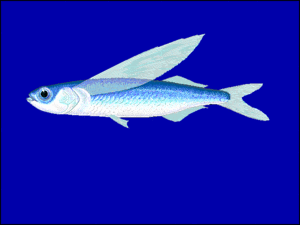Beloniformes facts for kids
Quick facts for kids Beloniformes |
|
|---|---|
 |
|
| Exocoetus volitans | |
| Scientific classification |
|
| Kingdom: | Animalia |
| Phylum: | Chordata |
| Class: | Actinopterygii |
| (unranked): | Ovalentaria |
| Order: | Beloniformes L. S. Berg, 1937 |
| Type species | |
| Belone belone Linnaeus 1761
|
|
| Families | |
|
|
The Beloniformes are an order of fish that includes six different families. There are about 264 known species in this group! These fish are a type of ray-finned fish, which means their fins are supported by bony rays. You can find them in both fresh water and the ocean.
Some of the well-known families in this order are:
- Adrianichthyidae (like ricefish and medakas)
- Belonidae (needlefish)
- Exocoetidae (flyingfishes)
- Hemiramphidae (halfbeaks)
- Scomberesocidae (sauries)
- Zenarchopteridae (viviparous halfbeaks)
Most Beloniformes are sleek, medium-sized fish. They usually live near the water's surface. They eat different things like algae, tiny ocean creatures called plankton, or even smaller fish. While most of them live in the sea, some needlefish and halfbeaks can be found in brackish water (a mix of fresh and salt water) and fresh water.
Contents
Fish Families and Their Features
Scientists sometimes divide the Beloniformes order into two main groups, called suborders. One is the Adrianichthyoidei, which only contains the Adrianichthyidae family (the ricefish). These fish were once thought to be related to killifish. However, new studies show they are closer to Beloniformes because they have a fixed upper jaw. This means they can't push their upper jaw forward.
The other big group is called the Exocoetoidei. This group can be split even further into two superfamilies:
- Scomberesocoidea: This group includes the needlefish and sauries.
- Exocoetoidea: This group includes the flyingfishes, halfbeaks, and viviparous halfbeaks.
Newer research suggests that flyingfishes are actually a type of halfbeak. Also, needlefish and sauries might be types of viviparous halfbeaks. This shows how scientists are always learning more about how these fish are related!
Amazing Jaws of Beloniformes
One cool thing about Beloniformes is their different jaw shapes.
- Halfbeaks: When they are young and as adults, halfbeaks usually have a longer lower jaw. This is like the basic jaw shape for most fish in this order (except for the ricefish).
- Needlefish and Sauries: Most young needlefish and sauries start with a "halfbeak stage," meaning they have a long lower jaw. But as they grow up, both their upper and lower jaws become long.
- Flyingfishes: In flyingfishes and some halfbeak types, the long lower jaw disappears as they grow into adults. It's even gone in most young flyingfishes.
Why Beloniformes are Important
Beloniformes are used for many things, including fishing for food. There are about 260 different species, which is a lot of variety!
Scientists are also very interested in Beloniformes. They are studying their DNA, especially something called mitochondrial DNA (mtDNA). This helps them understand how these fish have changed over time. By studying Beloniformes, scientists can learn more about evolution and even identify different fish larvae (baby fish).
Timeline of Genera

See also
 In Spanish: Beloniformes para niños
In Spanish: Beloniformes para niños

